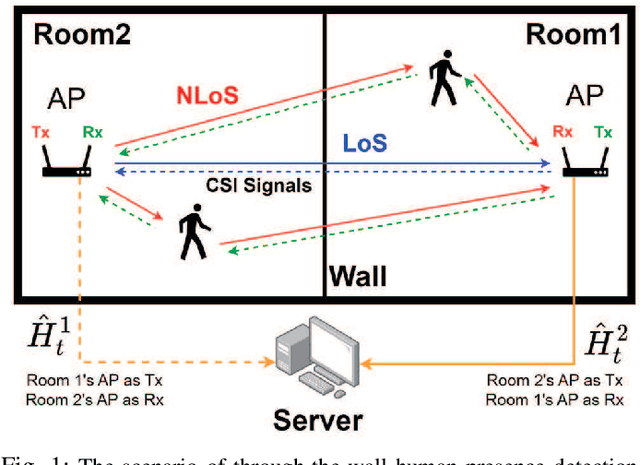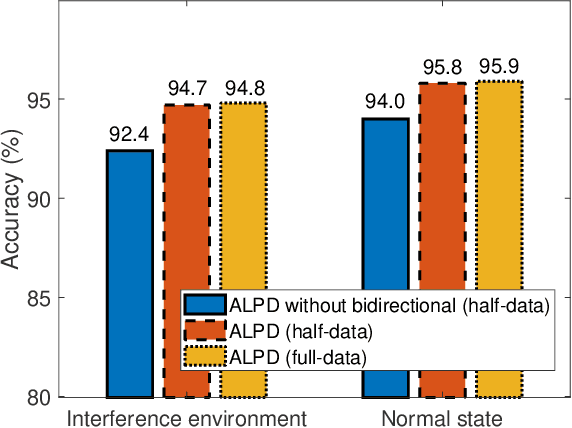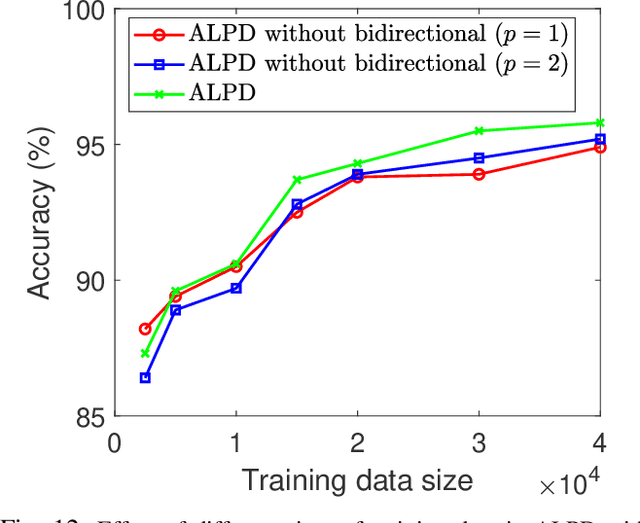An-Hung Hsiao
SALC: Skeleton-Assisted Learning-Based Clustering for Time-Varying Indoor Localization
Jul 14, 2023Abstract:Wireless indoor localization has attracted significant amount of attention in recent years. Using received signal strength (RSS) obtained from WiFi access points (APs) for establishing fingerprinting database is a widely utilized method in indoor localization. However, the time-variant problem for indoor positioning systems is not well-investigated in existing literature. Compared to conventional static fingerprinting, the dynamicallyreconstructed database can adapt to a highly-changing environment, which achieves sustainability of localization accuracy. To deal with the time-varying issue, we propose a skeleton-assisted learning-based clustering localization (SALC) system, including RSS-oriented map-assisted clustering (ROMAC), cluster-based online database establishment (CODE), and cluster-scaled location estimation (CsLE). The SALC scheme jointly considers similarities from the skeleton-based shortest path (SSP) and the time-varying RSS measurements across the reference points (RPs). ROMAC clusters RPs into different feature sets and therefore selects suitable monitor points (MPs) for enhancing location estimation. Moreover, the CODE algorithm aims for establishing adaptive fingerprint database to alleviate the timevarying problem. Finally, CsLE is adopted to acquire the target position by leveraging the benefits of clustering information and estimated signal variations in order to rescale the weights fromweighted k-nearest neighbors (WkNN) method. Both simulation and experimental results demonstrate that the proposed SALC system can effectively reconstruct the fingerprint database with an enhanced location estimation accuracy, which outperforms the other existing schemes in the open literature.
Time-Selective RNN for Device-Free Multi-Room Human Presence Detection Using WiFi CSI
Apr 25, 2023Abstract:Human presence detection is a crucial technology for various applications, including home automation, security, and healthcare. While camera-based systems have traditionally been used for this purpose, they raise privacy concerns. To address this issue, recent research has explored the use of channel state information (CSI) approaches that can be extracted from commercial WiFi access points (APs) and provide detailed channel characteristics. In this thesis, we propose a device-free human presence detection system for multi-room scenarios using a time-selective conditional dual feature extract recurrent Network (TCD-FERN). Our system is designed to capture significant time features with the condition on current human features using a dynamic and static (DaS) data preprocessing technique to extract moving and spatial features of people and differentiate between line-of-sight (LoS) path blocking and non-blocking cases. To mitigate the feature attenuation problem caused by room partitions, we employ a voting scheme. We conduct evaluation and real-time experiments to demonstrate that our proposed TCD-FERN system can achieve human presence detection for multi-room scenarios using fewer commodity WiFi APs.
Attention-Enhanced Deep Learning for Device-Free Through-the-Wall Presence Detection Using Indoor WiFi System
Apr 25, 2023



Abstract:Accurate detection of human presence in indoor environments is important for various applications, such as energy management and security. In this paper, we propose a novel system for human presence detection using the channel state information (CSI) of WiFi signals. Our system named attention-enhanced deep learning for presence detection (ALPD) employs an attention mechanism to automatically select informative subcarriers from the CSI data and a bidirectional long short-term memory (LSTM) network to capture temporal dependencies in CSI. Additionally, we utilize a static feature to improve the accuracy of human presence detection in static states. We evaluate the proposed ALPD system by deploying a pair of WiFi access points (APs) for collecting CSI dataset, which is further compared with several benchmarks. The results demonstrate that our ALPD system outperforms the benchmarks in terms of accuracy, especially in the presence of interference. Moreover, bidirectional transmission data is beneficial to training improving stability and accuracy, as well as reducing the costs of data collection for training. Overall, our proposed ALPD system shows promising results for human presence detection using WiFi CSI signals.
Attention-based Learning for Sleep Apnea and Limb Movement Detection using Wi-Fi CSI Signals
Mar 26, 2023Abstract:Wi-Fi channel state information (CSI) has become a promising solution for non-invasive breathing and body motion monitoring during sleep. Sleep disorders of apnea and periodic limb movement disorder (PLMD) are often unconscious and fatal. The existing researches detect abnormal sleep disorders in impractically controlled environments. Moreover, it leads to compelling challenges to classify complex macro- and micro-scales of sleep movements as well as entangled similar waveforms of cases of apnea and PLMD. In this paper, we propose the attention-based learning for sleep apnea and limb movement detection (ALESAL) system that can jointly detect sleep apnea and PLMD under different sleep postures across a variety of patients. ALESAL contains antenna-pair and time attention mechanisms for mitigating the impact of modest antenna pairs and emphasizing the duration of interest, respectively. Performance results show that our proposed ALESAL system can achieve a weighted F1-score of 84.33, outperforming the other existing non-attention based methods of support vector machine and deep multilayer perceptron.
A New Paradigm for Device-free Indoor Localization: Deep Learning with Error Vector Spectrum in Wi-Fi Systems
Mar 25, 2023



Abstract:The demand for device-free indoor localization using commercial Wi-Fi devices has rapidly increased in various fields due to its convenience and versatile applications. However, random frequency offset (RFO) in wireless channels poses challenges to the accuracy of indoor localization when using fluctuating channel state information (CSI). To mitigate the RFO problem, an error vector spectrum (EVS) is conceived thanks to its higher resolution of signal and robustness to RFO. To address these challenges, this paper proposed a novel error vector assisted learning (EVAL) for device-free indoor localization. The proposed EVAL scheme employs deep neural networks to classify the location of a person in the indoor environment by extracting ample channel features from the physical layer signals. We conducted realistic experiments based on OpenWiFi project to extract both EVS and CSI to examine the performance of different device-free localization techniques. Experimental results show that our proposed EVAL scheme outperforms conventional machine learning methods and benchmarks utilizing either CSI amplitude or phase information. Compared to most existing CSI-based localization schemes, a new paradigm with higher positioning accuracy by adopting EVS is revealed by our proposed EVAL system.
Semi-Supervised Bifold Teacher-Student Learning for Indoor Presence Detection Under Time-Varying CSI
Dec 21, 2022



Abstract:In recent years, there have been abundant researches focused on indoor human presence detection based on laborious supervised learning (SL) and channel state information (CSI). These existing studies adopt spatial information of CSI to improve detection accuracy. However, channel is susceptible to arbitrary environmental changes in practice, such as the object movement, atmospheric factors and machine rebooting, which leads to degraded prediction accuracy. However, the existing SL-based methods require to re-train a new model with time-consuming labeling. Therefore, designing a semi-supervised learning (SSL) based scheme by continuously monitoring model "life-cycle" becomes compellingly imperative. In this paper, we propose bifold teacher-student (BTS) learning for presence detection system, which combines SSL by utilizing partial labeled and unlabeled dataset. The proposed primal-dual teacher-student network is capable of intelligently learning spatial and temporal features from labeled and unlabeled CSI. Additionally, the enhanced penalized loss function leveraging entropy and distance measure can distinguish the drifted data, i.e., features of new dataset are affected by time-varying effect and are alternated from the original distribution. The experimental results demonstrate that the proposed BTS system can sustain the asymptotic accuracy after retraining the model with unlabeled data. Moreover, label-free BTS outperforms the existing SSL-based models in terms of the highest detection accuracy, while achieving the similar performance of SL-based methods.
CRONOS: Colorization and Contrastive Learning Enhanced NLoS Human Presence Detection using Wi-Fi CSI Signals
Nov 07, 2022Abstract:In recent years, demands of pervasive smart services and applications increase explosively. Device-free human detection through sensors or cameras has been widely adopted but with privacy issues as well as misdetection for motionless people. To resolve these defects, channel state information (CSI) captured from commercialized Wi-Fi devices is capable of providing plentiful signal features for accurate detection. The existing systems has inaccurate classification under a non-line-of-sight (NLoS) and stationery scenario of a person standing still at corner in a room. In this work, we have proposed a colorization and contrastive learning enhanced NLoS human presence detection (CRONOS) system. CRONOS is capable of generating dynamic recurrence plots (RPs) and coloring CSI ratios to distinguish mobile people and vacancy of a room, respectively. Furthermore, supervised contrastive learning is conceived to retrieve substantial representations, where consultation loss is formulated to differentiate the representative distances between dynamic and stationery cases. Furthermore, a self-switched static feature enhanced classifier (S3FEC) is proposed to determine the utilization of either RPs or coloring CSI ratio. Finally, comprehensive experimental results have revealed that our proposed CRONOS outperforms the existing systems applying machine learning, non-learning based methods as well as non-CSI based features in open literature, which achieves the highest presence detection accuracy and moderate computational complexity in vacancy, mobility, LoS and NLoS scenarios.
 Add to Chrome
Add to Chrome Add to Firefox
Add to Firefox Add to Edge
Add to Edge